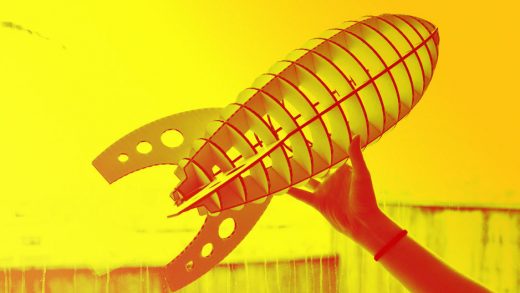This Team Built And Sold A New Product In Nine Weeks–Then Shelved It
What is it that the customer wants? What is the problem they face each day? What services are they hiring out for that we could meet with a bit of software? What if we could help people create better social media ads? What if that isn’t quite the problem, but rather tracking and spending ad dollars wisely? What if? What if? What if?
Sometimes a series of “what ifs” or “whys” can lead to new and exciting places. For three Buffer teammates, an exploration of “what ifs” created a whole new venture—at least for a short while.
In determining the best possible path for our social media photo creation tool, Pablo, they embarked upon a nine-week journey that challenged and stretched them like never before—and ultimately created a new nine-week accelerator program at Buffer.
From An Experimental Sprint To A Nine-Week Accelerator
Roy, Phil, and James were quite familiar with working together—all worked together on Pablo, a quick and easy way to share images on social.
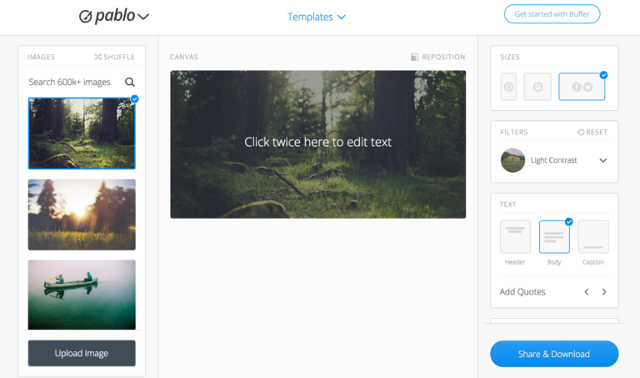
The team at Pablo, which had been functioning as a “startup within a startup” for some time, began to experiment with ways to grow faster in May and June of 2016. They were growing at about 4% week over week, but wanted to get to 25% to 50% growth instead.
Try as they might, they couldn’t seem to get usage numbers to change on Pablo as exponentially as they hoped, no matter the marketing or product tweaks. So they dug in a bit more. How could they set Pablo apart as a product? One pain point that came up again and again for customers was Facebook Ads. What if Pablo could help people create more effective Facebook Ads?
This was the spark that lit the way to taking a new direction. James, Pablo’s designer and front end developer, did a mockup of what this product, then called Ad Rocket, might look like as a quick side project—their attention was still focused on growing Pablo. Then they took this to Joel and Leo, Buffer’s cofounders.
“Let’s do it!” Leo said, suggesting they treat this idea as a sprint (based on the book Sprint: How to Solve Big Problems and Test New Ideas in Just Five Days.) So the Pablo team got to work. The premise behind a sprint is to take five days to validate a solution to a problem.
- Days 1–3: Research and deep thinking
- Day 4: Build the product or feature
- Day 5: Show to customers for instant feedback
- Their first week provided a ton of lessons and they moved into a second week of a sprint and then a third.
Here is an early prototype:
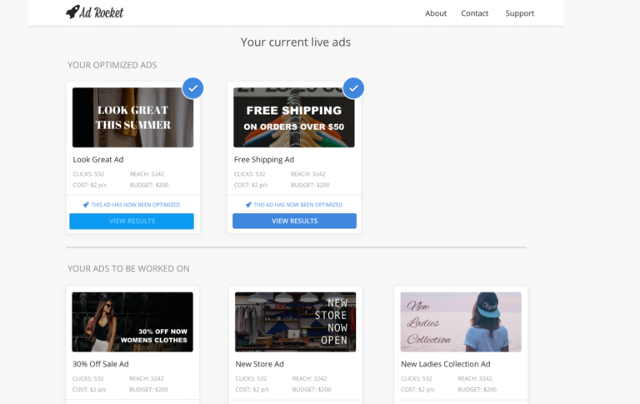
After a few weeks of these sprints, the Pablo team approached Joel and Leo again and shared that the idea definitely had some legs as a product separate from Pablo.

Joel and Leo gave the team the go-ahead with the framework of a lean accelerator program:
- Nine weeks to work on the project
- Goal to reach product-market-fit
- At the end, they’d evaluate whether Buffer would continue to fund it
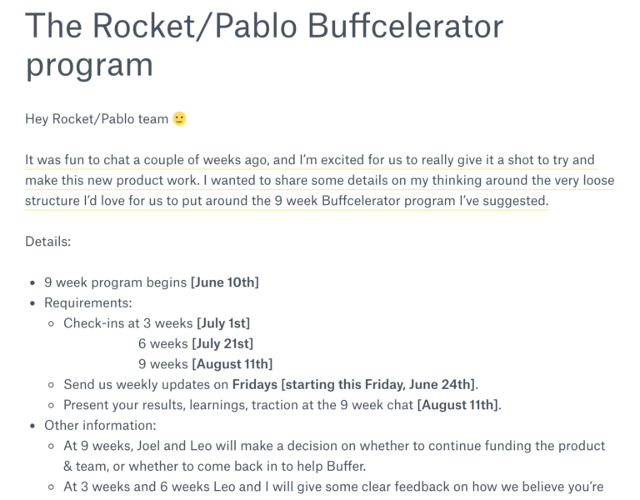
The gate opened; the race was on!
The Summer Of Rocket
The team dove into more customer calls, product iterations, and brainstorming sessions. They learned a few key things that sent the product in a new direction. Originally, the Rocket crew postulated that people needed help creating images and crafting ads themselves. Second, most people and agencies struggled not with the creative but with optimizing ads and knowing where to target their advertising dollars. And third, people had reservations with third-party apps handling their ad money.
The iterations of Rocket then evolved in similar ways. The first version honed in on trust issues, featuring an extension in Facebook Ads Manager to help generate reports and analytics. Another idea was an auto-optimizer: Press a button and instantly an optimized ad is posted. However, most people wanted a bit more control than this.
Eventually, the key finding from the Rocket team was that many agencies, freelance consultants, and in-house ad managers were struggling to analyze the data from ads. Some were hiring people to put data from Facebook Ads Manager into spreadsheets in order to draw conclusions on what was and wasn’t working.
So Rocket began to form more clearly as a dashboard to view your ads’ performance.
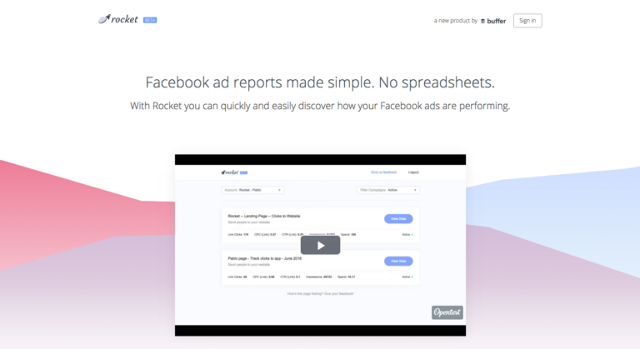

The small team’s roles all blended together as they jumped into customer calls, researched more about Facebook ads, and made product adjustments.
Here’s an update from the team from July.
“One Moment We’re Good, Then We’re Dead”
There was a deeper sense of pressure with the nine-week deadline and even a sense of isolation from the rest of the Buffer team. Days were longer, the responsibility for each person greater. There were fewer team members to fall back on if something was broken or needed to be done. It created a deep bond for the three teammates who were learning and growing on a much faster scale.
“It was the typical ride for a startup,” said Roy of the roller coaster of emotions throughout. “One moment we’re good, then, we’re awesome, then, oh no, we’re dead.”
James called this the “summer of Rocket” as the nine weeks required him to work more than he ever had—and he learned more than ever. “There was so much motivation to make this work (with the nine-week deadline also looming), it didn’t seem to matter that we were working more,” James said. “Toward the end of the project, I realized my energy levels were really low and I had almost burnt out. I had to take a day or so off and then really set up a schedule where I was taking regular breaks.”
As the end of the three months loomed, the team pushed for their minimum viable product to reach product-market fit and sought one of the biggest milestones they had yet to reach: paying customers.
They reached that goal on August 12, just before the end of the accelerator period, with Rocket’s first paying customer.

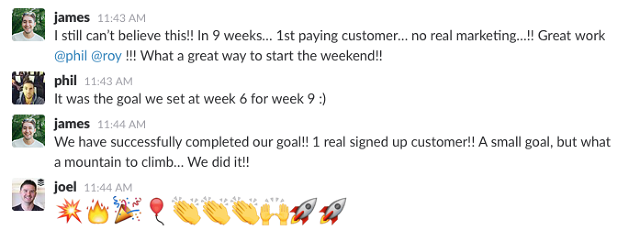
The team knew Rocket was definitely solving a problem. But would it be enough?
Time To Pitch
The goal of the “Buffercelerator” was to validate a project in nine weeks with paying customers. This is perhaps one of the best signals of whether the product has “made it” as an MVP.
When the Rocket team pitched the product to Joel and Leo for further investment, they had at least one paying customer and knew there were people who liked the idea of Rocket.
James said, though, that when they showed customers the product itself, they were less enthusiastic. So as the Rocket team pitched the product to Joel and Leo for further investment, they had no idea which direction their “investors” would go.
Here’s their full pitch deck:
After thinking things over, Joel and Leo decided not to move forward as an angel investor in Rocket—but they did leave the possibility open for the team to keep going if they chose to. Rocket’s future, if the team chose it, would look like this:
- Rocket receives $25,000 per founder, to last a four-month period.
- Each team member receives 10% equity ownership of Rocket.
- You’d present Rocket to us at the end of the year (early January), for true seed investment.
- By that point we’d want to see very real traction and revenue growth.
Here’s the whole note Joel and Leo shared with the team laying out the options:

After nine weeks at a breakneck pace, Roy, James, and Phil took some time to discuss whether to go forward with Rocket or return to the Buffer team. Roy remembers that Leo once told him you need to be prepared to crawl through the pit of hell for your startup to put in the work required to make it. And that feeling might last for years, so a passion for the product and mission is key.
They considered, “If the three of us met outside of working at Buffer, would we have formed this product?” The answer was, “Probably not.” While they loved the experience of Rocket and all they’d accomplished together, they weren’t as passionate about the product as they perhaps needed to be to continue.
“There’s definitely a market.” James said. “It’s definitely a problem people face. Was it the right market for Buffer? That would make sense in the product line for Buffer? I don’t know. It was such a narrow problem for such a small group of people that we would have had to charge a lot to make it profitable. Compared to Buffer’s product line, we questioned whether it made sense to go that route.”
The three of them sent this reply to Joel and Leo’s offer:
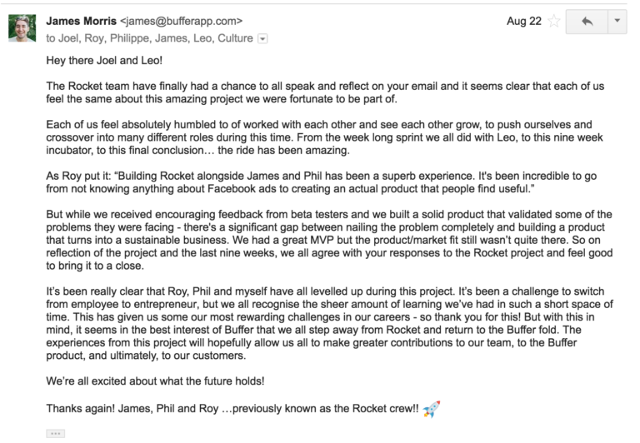
Success In Sunsetting Rocket
And with that, the Rocket crew shuttered the project they’d spent more than nine weeks of total focus on.
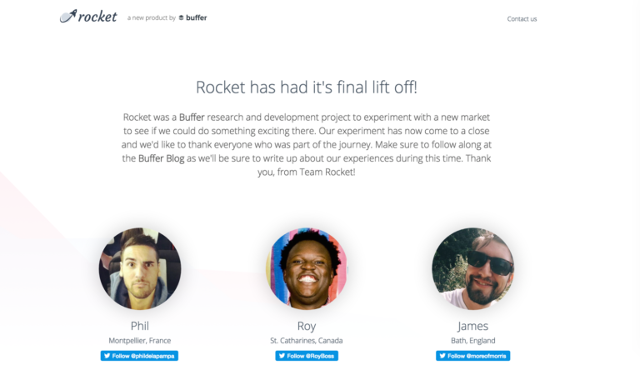
James, Roy, and Phil have rejoined the Buffer team, with Roy as a customer researcher, James a product designer, and Phil an engineer. All three are quick to say that the program was a success in its own way, despite not continuing.
“For all three of us, we all have more confidence to do something new,” Roy said. “Once you’ve walked through something like this once and had that experience, that muscle has been built.” Phil shared that he had feared if the verdict from Joel and Leo was a “no,” it would mean that they hadn’t done things right. As the end came, however, he realized that the team had still reached the goals they set for themselves and even had paying customers. The timing might not have been right for Buffer to invest, but it was still a massive achievement.
Would they do it again? The answer for all three is a resounding yes. “In the busy-ness of building a product, there are a thousand things swirling through our minds, so learning what to prioritize is key,” Roy said. “In an environment where everything is moving so quickly, you can spend your time doing lots of really good things, or you can find the most pressing need that you can fill to free up your teammates to do the things they’re best at.”
“This was overwhelmingly one of the most satisfying experiences I’ve ever had,” James said. “We stretched ourselves more than we ever expected and operated with a lot of autonomy in the process. It was exhilarating.”
This article originally appeared on Buffer and is reprinted with permission.
Fast Company , Read Full Story
(27)

